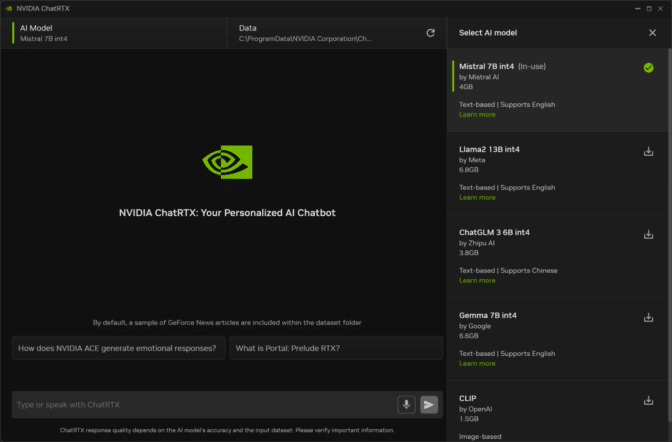Editor’s note: This post is part of the AI Decoded series, which demystifies AI by making the technology more accessible, and showcases new hardware, software, tools and accelerations for RTX PC users.
NVIDIA is spotlighting the latest NVIDIA RTX-powered tools and apps at SIGGRAPH, an annual trade show at the intersection of graphics and AI.
These AI technologies provide advanced ray-tracing and rendering techniques, enabling highly realistic graphics and immersive experiences in gaming, virtual reality, animation and cinematic special effects. RTX AI PCs and workstations are helping drive the future of interactive digital media, content creation, productivity and development.
ACE’s AI Magic
During a SIGGRAPH fireside chat, NVIDIA founder and CEO Jensen Huang introduced “James” — an interactive digital human built on NVIDIA NIM microservices — that showcases the potential of AI-driven customer interactions.
Using NVIDIA ACE technology and based on a customer-service workflow, James is a virtual assistant that can connect with people using emotions, humor and contextually accurate responses. Soon, users will be able to interact with James in real time at ai.nvidia.com.

NVIDIA also introduced the latest advancements in the NVIDIA Maxine AI platform for telepresence, as well as companies adopting NVIDIA ACE, a suite of technologies for bringing digital humans to life with generative AI. These technologies enable digital human development with AI models for speech and translation, vision, intelligence, realistic animation and behavior, and lifelike appearance.
Maxine features two AI technologies that enhance the digital human experience in telepresence scenarios: Maxine 3D and Audio2Face-2D.
Developers can harness Maxine and ACE technologies to drive more engaging and natural interactions for people using digital interfaces across customer service, gaming and other interactive experiences.
Tapping advanced AI, NVIDIA ACE technologies allow developers to design avatars that can respond to users in real time with lifelike animations, speech and emotions. RTX GPUs provide the necessary computational power and graphical fidelity to render ACE avatars with stunning detail and fluidity.
With ongoing advancements and increasing adoption, ACE is setting new benchmarks for building virtual worlds and sparking innovation across industries. Developers tapping into the power of ACE with RTX GPUs can build more immersive applications and advanced, AI-based, interactive digital media experiences.
RTX Updates Unleash AI-rtistry for Creators
NVIDIA GeForce RTX PCs and NVIDIA RTX workstations are getting an upgrade with GPU accelerations that provide users with enhanced AI content-creation experiences.
For video editors, RTX Video HDR is now available through Wondershare Filmora and DaVinci Resolve. With this technology, users can transform any content into high dynamic range video with richer colors and greater detail in light and dark scenes — making it ideal for gaming videos, travel vlogs or event filmmaking. Combining RTX Video HDR with RTX Video Super Resolution further improves visual quality by removing encoding artifacts and enhancing details.
RTX Video HDR requires an RTX GPU connected to an HDR10-compatible monitor or TV. Users with an RTX GPU-powered PC can send files to the Filmora desktop app and continue to edit with local RTX acceleration, doubling the speed of the export process with dual encoders on GeForce RTX 4070 Ti or above GPUs. Popular media player VLC in June added support for RTX Video Super Resolution and RTX Video HDR, adding AI-enhanced video playback.
Read this blog on RTX-powered video editing and the RTX Video FAQ for more information. Learn more about Wondershare Filmora’s AI-powered features.
In addition, 3D artists are gaining more AI applications and tools that simplify and enhance workflows, including Replikant, Adobe, Topaz and Getty Images.
Replikant, an AI-assisted 3D animation platform, is integrating NVIDIA Audio2Face, an ACE technology, to enable improved lip sync and facial animation. By taking advantage of NVIDIA-accelerated generative models, users can enjoy real-time visuals enhanced by RTX and NVIDIA DLSS technology. Replikant is now available on Steam.
Adobe Substance 3D Modeler has added Search Asset Library by Shape, an AI-powered feature designed to streamline the replacement and enhancement of complex shapes using existing 3D models. This new capability significantly accelerates prototyping and enhances design workflows.
New AI features in Adobe Substance 3D integrate advanced generative AI capabilities, enhancing its texturing and material-creation tools. Adobe has launched the first integration of its Firefly generative AI capabilities into Substance 3D Sampler and Stager, making 3D workflows more seamless and productive for industrial designers, game developers and visual effects professionals.
For tasks like text-to-texture generation and prompt descriptions, Substance 3D users can generate photorealistic or stylized textures. These textures can then be applied directly to 3D models. The new Text to Texture and Generative Background features significantly accelerate traditionally time-consuming and intricate 3D texturing and staging tasks.
Powered by NVIDIA RTX Tensor Cores, Substance 3D can significantly accelerate computations and allows for more intuitive and creative design processes. This development builds on Adobe’s innovation with Firefly-powered Creative Cloud upgrades in Substance 3D workflows.
Topaz AI has added NVIDIA TensorRT acceleration for multi-GPU workflows, enabling parallelization across multiple GPUs for supercharged rendering speeds — up to 2x faster with two GPUs over a single GPU system, and scaling further with additional GPUs.
Getty Images has updated its Generative AI by iStock service with new features to enhance image generation and quality. Powered by NVIDIA Edify models, the latest enhancement delivers generation speeds set to reach around six seconds for four images, doubling the performance of the previous model, with speeds at the forefront of the industry. The improved Text-2-Image and Image-2-Image functionalities provide higher-quality results and greater adherence to user prompts.
Generative AI by iStock users can now also designate camera settings such as focal length (narrow, standard or wide) and depth of field (near or far). Improvements to generative AI super-resolution enhances image quality by using AI to create new pixels, significantly improving resolution without over-sharpening the image.
LLM-azing AI
ChatRTX — a tech demo that connects a large language model (LLM), like Meta’s Llama, to a user’s data for quickly querying notes, documents or images — is getting a user interface (UI) makeover, offering a cleaner, more polished experience.
ChatRTX also serves as an open-source reference project that shows developers how to build powerful, local, retrieval-augmented applications (RAG) applications accelerated by RTX.

The latest version of ChatRTX, released today, uses the Electron + Material UI framework, which lets developers more easily add their own UI elements or extend the technology’s functionality. The update also includes a new architecture that simplifies the integration of different UIs and streamlines the building of new chat and RAG applications on top of the ChatRTX backend application programming interface.
End users can download the latest version of ChatRTX from the ChatRTX web page. Developers can find the source code for the new release on the ChatRTX GitHub repository.
Meta Llama 3.1-8B models are now optimized for inference on NVIDIA GeForce RTX PCs and NVIDIA RTX workstations. These models are natively supported with NVIDIA TensorRT-LLM, open-source software that accelerates LLM inference performance.
Dell’s AI Chatbots: Harnessing RTX Rocket Fuel
Dell is presenting how enterprises can boost AI development with an optimized RAG chatbot using NVIDIA AI Workbench and an NVIDIA NIM microservice for Llama 3. Using the NVIDIA AI Workbench Hybrid RAG Project, Dell is demonstrating how the chatbot can be used to converse with enterprise data that’s embedded in a local vector database, with inference running in one of three ways:
- Locally on a Hugging Face TGI server
- In the cloud using NVIDIA inference endpoints
- On self-hosted NVIDIA NIM microservices
Learn more about the AI Workbench Hybrid RAG Project. SIGGRAPH attendees can experience this technology firsthand at Dell Technologies’ booth 301.
HP AI Studio: Innovate Faster With CUDA-X and Galileo
At SIGGRAPH, HP is presenting the Z by HP AI Studio, a centralized data science platform. Announced in October 2023, AI Studio has now been enhanced with the latest NVIDIA CUDA-X libraries as well as HP’s recent partnership with Galileo, a generative AI trust-layer company. Key benefits include:
- Deploy projects faster: Configure, connect and share local and remote projects quickly.
- Collaborate with ease: Access and share data, templates and experiments effortlessly.
- Work your way: Choose where to work on your data, easily switching between online and offline modes.
Designed to enhance productivity and streamline AI development, AI Studio allows data science teams to focus on innovation. Visit HP’s booth 501 to see how AI Studio with RAPIDS cuDF can boost data preprocessing to accelerate AI pipelines. Apply for early access to AI Studio.
An RTX Speed Surge for Stable Diffusion
Stable Diffusion 3.0, the latest model from Stability AI, has been optimized with TensorRT to provide a 60% speedup.
A NIM microservice for Stable Diffusion 3 with optimized performance is available for preview on ai.nvidia.com.
There’s still time to join NVIDIA at SIGGRAPH to see how RTX AI is transforming the future of content creation and visual media experiences. The conference runs through Aug. 1.
Generative AI is transforming graphics and interactive experiences of all kinds. Make sense of what’s new and what’s next by subscribing to the AI Decoded newsletter.
